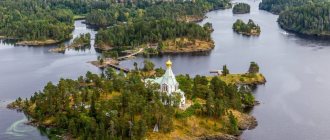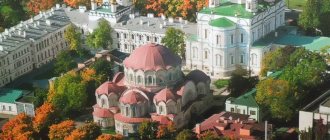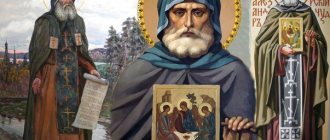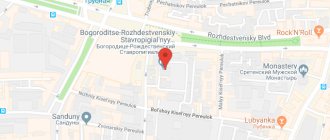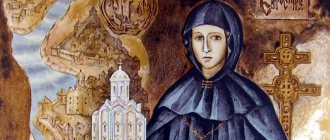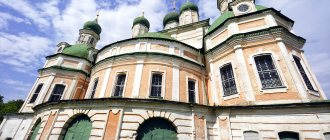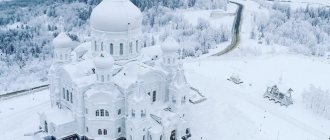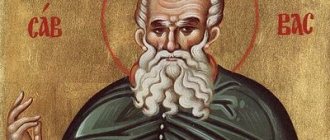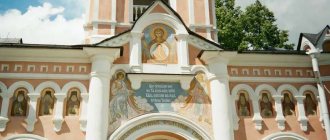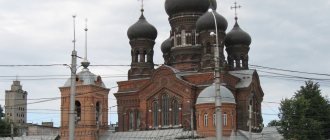Where is the Valaam Monastery located?
The holy monastery is located in Karelia, on a huge island in the northern part of Lake Ladoga, or rather on an entire archipelago of more than 50 individual islands. The largest of them is the island of Valaam, but other areas of land also belong to the territory of the monastery.
Valaam and the coast are separated by about 22 km. The nearest settlement near Valaam is the city of Sortavala, it is located 42 km from the monastery. Despite the fact that from the map it seems that the Valaam Monastery is located not far from St. Petersburg, in fact it is more than 200 km from the northern capital to the holy monastery.
Information for pilgrims and tourists
Valaam is a great place if you want to get away from the hustle and bustle for a while, be alone with faith, and think about the salvation of your soul.
Official information about the holy monastery can be found on the website https://valaam.ru .
Purpose of visiting the monastery
But pilgrims come and go here from all parts of the world, to touch this shrine, from here to send their prayer, so that it becomes warmth, food and consolation, so that the inner eyes are directed towards arranging the beauty of their soul.
Tourists flock here to see this miracle with their own eyes, this almost pristine beauty, to enjoy the peace, tranquility and comfort of these places.
This is important: there is nothing to do here without faith. This is the real kingdom of stone. You will either become a stone or you will leave. The statistics of Valaam are direct confirmation of this. Only one out of twenty novices remains in the monastery.
Description of the Valaam Monastery
The Valaam Monastery in Karelia belongs to the category of stauropegial, which means that the monastery is directly subordinate to the Patriarch of Moscow and All Rus', although the actual management of the monastery according to the ancient charter is carried out by the abbot.
The ancient holy monastery occupies the huge island of Valaam with an area of about 30 square meters. km, the monastery's hermitages are scattered across fifty small islands in the immediate vicinity. The monastery is located in a very picturesque corner of nature - a rocky island rises high above sea level, the territory of Valaam is covered mainly by pine forests. The island has several internal lakes and a network of canals, artificially created in the 19th century.
In the video of the Valaam Monastery you can see that the monastery complex is very large and difficult to explore in one day. The monastery includes many churches, chapels and memorial crosses. Among the most famous buildings are the Transfiguration Cathedral and the White and Red Monasteries, the Church of the Assumption of the Blessed Virgin Mary, and the ancient houses of the Valaam Monastery.
On the territory of the Spaso-Preobrazhensky Valaam Monastery there are many outbuildings - a hotel founded in the ancient building of the Stable House, a Waterworks House, a bakery and a dairy farm, its own vehicle fleet and a modern outpatient clinic. The monastery owns arable land and orchards; the Valaam Monastery farm operates on the island. Throughout the year, the monks work on Valaam in the same way as in the old days, since the life of the island consists not only of prayers, but also of constant work.
Temples and shrines
To get to the monastery, you need to climb the mountain 30 meters above sea level. Mount Tabor on Valaam is surrounded on three sides by gardens that have been cultivated by monks for centuries. Opposite the entrance to the monastery there is a chapel, in the center of which is the icon of the Mother of God “The Sign”. The chapel was erected in 1862 in memory of the visit to the monastery by Emperor Alexander II and members of his family. Called Tsarskaya, it is built of Karelian marble with a plinth of gray granite.
The structure is in the form of a stone arch with a triangular pediment, into which is inserted a stone medallion with a carved inscription about the visit of the monastery by the royal family. Famous writers, artists and composers also loved to visit the holy protected place.
Not far from the Holy Gates of the monastery there is a monument to St. Andrew the First-Called . One of the 12 apostles, Andrew the First-Called was the first called by Jesus Christ to preach the Gospel. Traveling from Crimea to Rome through Ladoga, the Apostle Andrew set foot on the islands of the Valaam archipelago. In 2003, the relics of the Apostle Andrew, whose name is revered in Rus', were brought to Valaam from Greece. The monument to the first disciple of Christ was consecrated on Valaam in 2014 by Patriarch Kirill of Moscow and All Rus'.
The Transfiguration Cathedral is seen by everyone who arrives on the island. The lower church was consecrated in the name of St. Sergius and Herman, Valaam wonderworkers. Under the cover of the lower church of the Transfiguration Cathedral lie the relics of Saints Sergius and Herman. Above the shrine is the image of “The Lord Almighty with those coming” depicting the Venerables Sergius and Herman kneeling in prayer at the Valaam monastery. In the year of the 10th anniversary of the resumption of monastic life in the monastery, the icon streamed myrrh.
In the cathedral there is a copy of the Valaam Icon of the Mother of God. The Virgin Mary, dressed in a dark cherry cloak, holds the Child, whose left hand blesses. Through prayers at the Valaam Icon of the Mother of God, hundreds of sick people received healing. In 2005, for an unprecedented mission, a smaller copy was painted from the icon. From October 8 to October 11, she circled the Earth more than a thousand times aboard the Soyuz spacecraft.
A granite staircase with images of Russian saints along the walls leads to the Upper Church of the Transfiguration of the Lord. The bright, spacious and formal hall seats 3,000 people. The temple, built in 1896 in the Russian style, used 3.5 million bricks, which were prepared on the island from local clay. The walls and iconostasis were painted by monks from the Valaam school of painting.
During the Soviet years, the abandoned temple was slowly destroyed. Restoration began in 1980. On August 19, 2005, on the day of the Transfiguration of the Lord, the Ptriarch of Moscow and All Rus' consecrated the monastery cathedral.
The Gate Church of the Holy Apostles Peter and Paul is located above the Holy Gates - the main entrance to the monastery. The church was built in the style of Russian classicism, the decoration of the temple is austere. In 1940, the gilded columns that decorated the iconostasis were removed and used for decoration in the club. The temple is being restored.
Temple of the Holy Life-Giving Trinity and the Life-Giving Spring icon with a simple architectural appearance. The facade is decorated with cornices of complex profile and icons in medallions. This is a hospital temple. In 1814, a church was built in honor of the Life-Giving Spring icon. On the initiative of the benefactors of the temple, in 1837 a new, upper part of the temple was built and consecrated in honor of the Life-Giving Trinity.
The Church of the Assumption of the Blessed Virgin Mary was consecrated as a refectory church in 1785. It was built as a simple square building, topped with a small onion bed on a thin, blind drum. The walls of the temple are cut with shovels. During Soviet times, the building was occupied by a village store, but here 11 icons, painted in the 18th century specifically for the iconostasis, have been preserved in their places.
Every year, from May 22, the monastery is visited en masse by pilgrims, whose crossing takes place by water. Here you can venerate the relics of the righteous Anna - by touching the shrine, the relics of the mother of the Blessed Virgin Mary, Christian women get rid of infertility.
The relics of the prophet and Baptist John the Baptist, the Evangelist Matthew, the Apostle Paul and the Apostle Andrew the First-Called on Valaam are miraculous. Valaam is that corner on an island remote from civilization where every person will find something close, dear and intimate.
Hermitages of the Valaam archipelago
The monasteries of the Valaam Monastery deserve special consideration. The small temples and residential buildings on the small islands of the archipelago have great religious significance and a rich history.
White Monastery
The White Skete, or Skete of All Saints, is located on the Skete island of the same name. The monastery was founded at the end of the 17th century; initially it had several fraternal buildings and a stone church. The White Skete has particularly strict rules - female pilgrims are practically prohibited from entering here; you can only visit the territory of the skete on All Saints' Day during a religious procession.
Skete of John the Baptist
The monastery on Predtechensky Island was built in 1855 and at that time was a simple wooden chapel. In 1858, a wooden church with a bell, cast especially for the Valaam Monastery under Boris Godunov, was erected in its place. At the beginning of the 20th century, ancient crosses from the 17th and 18th centuries were kept in the monastery, as well as the ashes of Schemamonk Jonah, revered on Valaam.
Currently, monks still live in the monastery. However, you cannot go on an excursion to the monastery - the Forerunner Monastery is completely closed to visitors.
Red Monastery
The Red Monastery, which is also called the Resurrection or New Jerusalem, is located in the southern region of the island of Valaam. According to legend, it was on this spot that the cross was originally installed by the Apostle Andrew the First-Called himself. In 1846, a wooden chapel was erected on the site of the cross, and at the beginning of the twentieth century it was replaced by a two-story church. The monastery received its unofficial name, Red, because its buildings are made of red brick.
Monastery of St. Nicholas the Wonderworker
The small monastery on Cross Island was built in the mid-19th century and initially consisted of the Church of St. Nicholas the Wonderworker and the Church of St. John of Damascus. A few years after construction, a stone building with cells for the brothers was added; also in the 19th century, a lighthouse was located in the chapel of St. Nicholas the Wonderworker; lanterns were lit in the windows on especially dark nights.
Konevsky monastery
Konevsky monastery is located on Konevets Island on the shore of Lake Igumenskoye. The consecration of the monastery took place in 1870, but in the middle of the 20th century, under Soviet rule, the monastery was dismantled. In 2004 it was restored and re-consecrated. The monastery is known for the fact that in former times, not far from it, there was a cell of Hegumen Damascene, the abbot of the monastery from 1839 to 1881, who made a great contribution to the development and prosperity of Valaam.
Gethsemane Monastery
Gethsemane, or Yellow, monastery is located near the Mount of Olives and includes the Ascension Chapel, the Chapel of the Prayer of the Chalice and the Church of the Assumption of the Blessed Virgin Mary. The monastery was founded at the beginning of the twentieth century, but during the years of Soviet power it suffered quite a lot; restoration work is still underway on the territory of the monastery. The skete was re-consecrated in 1998.
Main Cathedral
The main building of the cathedral with blue domes was restored from 1987 to 1996.
This is one of the most grandiose cathedrals in Russia. Almost all of the painting was done by monks. It has its own unique symbolism. The name in honor of the Transfiguration of the Lord and the fact that it is located on the highest point of the island tells us that a person’s vices disappear as gradually as he climbs the mountain to God.
Since ancient times, monks have cherished the idea of creating an analogue of Jerusalem on the island - the mountain on which the monastery stands symbolizes Mount Tabor. Many buildings here are based on this idea: the Resurrection Monastery on Mount Zion, the Gethsemane Monastery under Mount Olivet, and so on.
For the interior painting of the walls of the cathedral, the painting of the Cathedral of Christ the Savior in Moscow, Vladimir Cathedral in Kyiv, Kazan and St. Isaac's Cathedrals in St. Petersburg was taken as a basis. And the monks who painted the walls took as a basis the paintings of the greatest artists A. Ivanov, F. Bruni, V. Vereshchagin, A. Egorov, V. Vasnetsov, Raphael, Titian, Dore.
But, of course, they didn’t just copy these works, but created their own, using the artists’ compositions as a basis.
Who founded the Valaam Monastery
The identity of the founder of the Valaam Monastery and the exact year of its foundation still remain in question. The monastery is so ancient that there is simply no reliable evidence of the beginning of its existence.
- Based on the life of St. Abraham of Rostov, it is suggested that the monastery was founded at the beginning of the 10th century by the monks Herman and Sergius, who came to Valaam from the Mediterranean and founded a monastic brotherhood on the island. At the same time, there are no written sources that would tell about the life of the monks themselves, but a number of chronicles mention the transfer of their relics in 1163 from Valaam to Novgorod.
- According to the texts of the life of Savvaty Solovetsky, the year of foundation of the monastery on Valaam is considered to be 1407.
- According to legend, the founder of the Valaam monastery is the Apostle Andrew the First-Called himself, who brought the good news of Christ to the northernmost lands and erected a stone cross on the rocks of Valaam.
Attention! In fact, it is possible to trace the history and development of the Valaam monastery only from the 16th century; it was during this period that references to the monastery begin to appear frequently in written sources.
Where to have lunch
If you come on an excursion, your meals are provided in the refectory of the Resurrection Skete. In a cafe called “Valaam Pilgrim” you can sit comfortably, eat and at the same time buy Valaam gingerbread. The food is delicious and the prices are quite reasonable.
At the monastery farm you will taste the freshest dairy products. At a small market near Bolshaya Nikonovskaya Bay you can buy smoked and dried fish, which is grown and prepared right here. And at the same time, stock up on water.
There are several cafes near the pier. “Meal in the Old Garden” will offer the first and second. Be sure to try the local pastries.
It is worth noting: it is quite obvious that you will not have to starve here.
By the way, tourists diligently feed local cats, of which there are many on the island.
What is Valaam Monastery famous for?
It is not for nothing that the Spaso-Preobrazhensky Valaam stauropegic monastery is one of the most famous monastic monasteries in Russia and the whole world. Every year tens of thousands of pilgrims come here, attracted by the ancient history of the monastery, the stunningly beautiful nature of Valaam and the special atmosphere that reigns on the island remote from civilization.
- Valaam is one of the most ancient monasteries in the Christian world. The legend directly connects its foundation with Christ’s disciple Andrew the First-Called, and even according to reliable written sources, the age of the monastery is at least 500 years.
- Valaam is located in an amazingly beautiful and clean natural area and is located at a considerable distance from the “world”, thanks to which during a trip to Valaam you can truly relax your soul from ordinary worries.
- On the vast territory of the Valaam Monastery there are many historical buildings and ancient temples, some of them have been preserved from ancient times, others have been restored in modern times. Valaam is of interest not only to pilgrims, but also to historians and cultural experts around the world.
- Many important Orthodox shrines are kept within the walls of the monastery - every year pilgrims come here to venerate the images and relics, ask for healing or enlightenment.
One of the most important features of the Valaam Monastery on Lake Ladoga is its particularly strict internal charter. It is not for nothing that the monastery is called “northern Athos” - the monks of Valaam avoid any worldly temptations, preach strict asceticism, work hard and truly devote their lives to serving God.
When to go
In summer. Ideal time to visit Valaam. It is during the summer season that the weather conditions are best and it is easiest to get to the island. And the best time to walk around Valaam.
Autumn-spring. The tourist season on Valaam is continuously connected with navigation. Meteors occur steadily from May to October. At other times, you need to clarify what the weather is like - storms often occur on Ladoga. Meteors may not appear for several days.
In winter. Non-tourist season for Valaam. This does not mean that the island is closed. It’s just that after navigation stops, you can only get here by hovercraft. And then only after the ice on Lake Ladoga gets stronger.
History of the Valaam Monastery
The exact date of foundation of the Valaam Monastery remains unknown - some sources place the foundation of the monastery in the 10th century, according to others, the monastery was founded in the 14th century. It is officially accepted that the history of the monastery began in 1407, and its founders were the pilgrims Herman and Sergius.
The monastery experienced its greatest prosperity in the 15th-16th centuries, when about 600 monks lived on its territory. At the beginning of the 17th century, Valaam fell into decline; during this period the island came under the control of Sweden, as a result of which the monastery was severely devastated. After the Northern War, the island returned to the borders of Russia, and by order of Peter I, the restoration of the monastery began in 1715.
In 1730, the wooden Assumption Cathedral was erected, but it did not last long; a fire in 1754 destroyed almost all the buildings. The next restoration of the monastery was facilitated by Empress Elizabeth. In 1774, the Cathedral of the Transfiguration of the Lord, the Assumption and St. Nicholas churches, as well as cell buildings were erected. Another 10 years later, under Abbot Nazariya, stone construction began on the territory of the monastery.
With the beginning of the 19th century, Valaam flourished again; active development was carried out on the territory, some of which has survived to this day. In 1839, the famous abbot of Damascus became the abbot of the monastery, who made a huge contribution to the architectural development of the monastery. Damascene not only initiated the construction of new cathedrals and churches, but contributed to the revival of classical monastic traditions in the monastery. The eldership was returned again, the rules of the monastery became much stricter, and its fame increased.
At the end of the 19th century, the number of inhabitants of the monastery was about 1000, and there was also a tendency to assign names from the New Testament to the surrounding area of the temple. The clergy hoped that soon the Valaam Monastery of the Transfiguration of the Savior could become the new Jerusalem.
In the twentieth century, difficult times came to Valaam. After the revolution, the monastery was not closed, since it was located not in Russia, but in Finland. However, changes came anyway, since Orthodox believers in Lutheran Finland were in the minority, and in 1923 the monastery was de-Russified. Divine services began to be held there in Finnish, and defensive structures were placed on the territory of the monastery in case of war with the Soviet Union. The monastery was forced to switch to the Gregorian calendar, and many monks left the monastery. During the Finnish-Soviet war, the exodus of monks from the Valaam Monastery intensified - the monks went to Finland and subsequently founded the New Valaam Monastery there.
In the 1930s, only about 400 monks remained in the monastery, suffering poverty and hunger. In 1940, after the return to the USSR, the monastery was finally closed, and a naval school was located on the territory of the monastery. In 1950, the territory of the monastery was given over to a home for the disabled, and in 1979 a museum-reserve was opened on Valaam.
The revival of the monastery began only in 1989, the Orthodox Church again took possession of most of the monastery buildings. In December 1989, 6 monks settled on the island, trying to revive the traditions and customs of Valaam, and in 1994 the monastery was re-consecrated.
Shrines of the Valaam Monastery
On the territory of the Valaam monastery there are many important shrines of the Orthodox world. Among them are:
- the relics of the venerable monks Sergius and Herman, they are kept in the Transfiguration Cathedral of the Valaam Monastery and are an object of worship for pilgrims from all over the world;
- The Valaam Icon of the Mother of God, a miraculous image painted in 1878 by the monk Alypius;
- the icon of St. Anna, this image is an exact copy of the original kept on Mount Athos, and according to legend, it saves women from infertility.
Also on Valaam there is a piece of the Holy Sepulcher from the Holy Land - the relic is kept in the Resurrection Skete of the monastery.
Schedule of services of the monastery
| Day of the week | Service | Start time |
| Monday Friday | Midnight Office Matins Hours, Liturgy Moleben Vespers Compline, canons | 5.00 5.45 7.30 13.25 17.00 18.00 |
| Saturday | Midnight Office Matins Hours, Liturgy Moleben Confession (general) All-night vigil | 5.00 5.45 7.30 13.25 18.45 19.00 |
| Sunday | Hours, Liturgy Vespers Compline, Akathist | 9.00 17.00 17.50 |
In the Valaam Monastery you can also order requests for health or remembrance. This can be done either by visiting the monastery in person or using the Internet.
Monks of the Valaam Monastery
The Valaam Monastery on the marvelous island of Valaam is famous for its strict rules, which largely repeat the traditions of the famous Athos. Currently, more than 200 monks live in the monastery, busy daily with prayers and hard work. The daily routine for the brethren of Valaam is as follows:
- at 17 o'clock in the evening, Little Compline begins in the monastery, followed by the monastic rule, three canons with an akathist to the Mother of God and the rite of forgiveness;
- at 21 o'clock after dinner there comes a time of silence, during which the monks read prayers in private and bow;
- at 22 o'clock one goes to bed, and already at 5 o'clock in the morning the Midnight Office and Matins take place;
- after this, an early liturgy is served, after which the monks go to morning tea and subsequent obediences;
- At 1 p.m., lunch follows, after which the works of the holy fathers are read and a prayer service is served at the relics of St. Herman and Sergius.
A feature of the life of monks is that each of the monks is under the authority of a spiritual father or abbot. The time and duration of cell prayers are determined individually for each monk.
Strict rules apply on the territory of the Valaam Monastery regarding the sleep of monks. At night, 4 to 5 hours are allotted for rest; monks can sleep another 1-2 hours during the day after lunch. According to the abbot of the Valaam Monastery, Hegumen Pankratiy, the rule on the duration of sleep is taken from the patristic books; they recommend sleeping no more than 6-7 hours.
Important! The choir of the Valaam Monastery is very famous; its members include graduates of the Choir School named after. Glinka and the St. Petersburg Conservatory. Rimsky-Korsakov, certified vocalists and conductors, singers of musical theaters and vocal groups of St. Petersburg.
№2 (100) / 13 •April• '11
Elena Ryseva Pilgrimage
•In this topic:•
Pilgrimage
Jerusalem impressions
There is hardly a person who has never heard anything about the marvelous island of Valaam in his life. Located in the northern part of Lake Ladoga, 22 km from the mainland, this wonderful island would have remained simply one of the most beautiful places on earth, a protected area of nature with unique plants and granite rocks, with the vast and majestic expanses of Lake Ladoga, if not for that spiritual life that arose here more than 10 centuries ago.
According to legend, the first to come to the island of Valaam was the holy Apostle Andrew the First-Called, who, enlightening the Slavs and Scythians, destroyed the pagan temples that were here and installed a stone cross. The founders of the monastery on Valaam were the holy monks Sergius and Herman of Valaam and wonderworkers of all Russia. Not much is known about their life, as well as about the history of the ancient monastery itself. Modern church historians still do not have a consensus on where the very name of the island – Valaam – came from. One of the monastery legends says that its name is associated with the name of the biblical prophet Valaam; according to another version, the name comes from the Finnish words “valo” - light and “varama” - high, rocky land.
Having visited Valaam, you remain under a deep and piercing impression of the opening beauty. The island met with rain, fog and wind. After the boat on which we sailed to the island through the persistent, rebellious waves of Lake Ladoga and clouds of impenetrable milky fog, we felt a little seasick. And already on the shore everything around continued to float and swirl. It was later that we learned that experiencing a slight rocking motion on the way to the island was even better: the monks say that this way the lake humbles the spirit.
The embracing silence, which was felt even through the worried conversations of pilgrims, and the noise of departing ships, beauty and grandeur, as if carefully hidden from the eyes of an impressionable pilgrim by a veil of gray rain, the very air, from which the coolness and freshness of a northern lake wafted - behind all this severity and severity one could discern the secret of monastic life on Valaam.
But the earthly beauty of these places is also a visible reflection of the heavenly, spiritual beauty - the beauty of the exploits of the life that many, many elders, ascetics, prayer books, and hermits led here. Today's story is dedicated to the Valaam elders, those who spiritualize the island of Valaam.
Saint Ignatius (Brianchaninov) considered the abbot's service to be the most difficult monastic obedience: “This burden is light and at the same time heavy. These ramen must bear the infirmities of the entire brotherhood. What strength must be in these ramens! And today, looking at the portrait of Father Damascus, you think that there is no exaggeration in these words. It’s not the abbot’s face, but a block of Valaam granite...
He never thought about high positions and titles, but the Lord vouchsafed him to serve as abbot of the Valaam Monastery for 42 years. Of course, all the abbots of the monastery went down in history: Father Nazarius, who led the monastery for 20 years, and Abbot Jonathan, who spent 10 years building the monastery, but today, when they talk about Valaam, they also remember the figure of Damascus, who made an invaluable contribution to the spiritual growth of the monastery.
Hegumen Damascene
The future abbot of the Valaam Monastery (in the world Damian Kononov) was born in 1795 in the Tver province, into a peasant family. Even as a child, an accident happened to him. The seven-year-old sister decided to give her brother a ride and dropped him. Damian broke his leg. The leg soon fused, but incorrectly; the boy had difficulty stepping on it, and every step he took was accompanied by pain. Damian could not help with the housework, otherwise his parents would not have let him go on pilgrimage during the time of need, when there is so much to do that there is no time to cross himself. As soon as Damian set off with the pilgrims, they felt relief from the pain, and returned home completely healed.
“In 1817, they freed me to go to the Solovetsky miracle workers, and I went alone with the Lord. Returning back, I really wanted to visit Valaam.”
And so Damian walks along the Valaam forest road and hears a voice behind:
- Well, brother, don’t you want to stay in the monastery?
- I wish, father, but I don’t know where God will bless.
- Stay, brother. We have three kinds of life here.
- Like this?
“Three,” confirmed the monk. “First they work in our monastery, then in the monastery, and then in the desert. Stay, brother.
Mentally, Damian immediately decided to stay on Valaam forever and asked:
– Who else could I consult with here for the benefit of my soul?
- But go to Father Euthymius, he knows everything, it’s not for nothing that the monks call him “spiritual wisdom.”
Elder Euthymius greeted Damian with a bow to the ground. The monk’s humility so struck the young man that, confused, he could only say: “I want to be saved, teach me!”
Remaining in the monastery and becoming a novice, Damian underwent various obediences: he sewed boots and mittens, kneaded kneading dough in a bread shop, and fed the poor. While on obedience in the bread shop, I didn’t eat even a crust of bread without a blessing, although sometimes I really wanted to eat a hot crust of bread that had just been taken out of the oven...
Tired of obedience, he never gave up prayer. The novices lived extremely strictly. They had nothing in their cells. Only an image, a book, a table, benches and boards, which stood in the corner during the day, and at night they were laid on the benches, making up a monastic bed, which was complemented by a basting pillow and felt. Even in winter, novices wore caftans; no one had fur coats at that time. Only Damian, when he became a contractor and became a guard of Valaam, received a short fur coat to go around the island and identify poachers on it, who at that time loved to shoot game or secretly cut down forest. Evil people shot at Damian more than once, but the Lord protected His servant.
Father Euthymius came every night at 12 o'clock to wake up the student for midnight prayer, knocking until Damian answered by knocking back. Then, without lighting the fire, Damian carried out the cell rule, and with the sound of the bell he hurried to the church. Six years later, Damian Kononov was tonsured a monk with the name Damascene and began to live in the monastery of All Saints. In monasteries, life is more strict; only those monks who had already succeeded in monastic feats were blessed to settle here.
After living in a monastery for two years, in 1827 Damascene settled in a remote desert to experience a third way of monastic life. The cell where Damascene lived was divided into four rooms. In one, the hermit was engaged in handicrafts, in another, he copied the books of the Holy Fathers, in the third, he performed prayer rules and bows. In the fourth room there was a pine coffin, which served as Damascus’s bed, and the lid was a blanket. When he warmed himself with the “warmth of the grave,” he opened his wooden blanket.
To maintain silence, Damascus asked that bread be placed for him in an appointed place. The hermit also had chains - iron chains that he wore to mortify the flesh. “If you start making bows,” Abbot Damascene said, “the iron will heat up so much that it will become completely hot. Another time he’ll grab you by the body, and it hurts so much! But my soul is cheerful and calm. Oh, if only I could spend my whole life like this!”
One day, pilgrims visited his cell and asked for several wooden spoons carved by the hermit as souvenirs. The guests offered money, but Damascene did not take it. In the evening, getting ready for bed, he found money left near his coffin. He immediately went to the monastery, found his visitors and gave the money back, saying:
- It’s not good, gentlemen, to tempt monks!
More than once he experienced even more terrible temptations: after living in the desert for seven years, he suffered a lot here from demons. On autumn nights, an enemy appeared to him in the form of a man with disheveled hair coming out of a lake. Sometimes the enemy attacked, causing despondency and boredom. The monk Damascus defended himself with prayer and the sign of the cross.
In 1838, Damascene was elected abbot of the Valaam Monastery. And the new abbot immediately set about strengthening discipline in the monastery: he demanded compliance with the Rules and himself was an example in this. Being the abbot of a first-class monastery, whose fame spread throughout Russia, gathering countless pilgrims from all over, Damascene did not betray his meekness and humility and never distinguished himself from the monastic brethren. He went to the common meal with everyone, being content with the common food, dressed the same with all the brethren, and always followed the common monastic prayer rule.
He was unusually able to combine internal prayer work (the abbot had the gift of mental prayer) and external work on the arrangement of the monastery. He is rightly called the “builder” of Valaam. Under him, 20 chapels, monasteries, worship crosses, bridges, roads were erected on Valaam, a steamship service from St. Petersburg was established for workers and pilgrims, a farm for 70 cows, a stable, a water supply house, and a pilgrimage hotel were built. All these buildings still stand today.
In his sermons, the priest was always simple and artless. One monk recalled the following words from his instructions: “Love God, run away from the world, sit in your cell. The cell will teach you everything good, and whoever sits in it for God’s sake will never get bored!”, “The cell is the school of Damascus, and the Lord is the Teacher in it.”
John the Silent
Once the writer Mikhail Yanson, who made a pilgrimage to Valaam, spoke of the monastic brethren this way: “Weak in literacy, powerful in soul, merciless to themselves, tireless prayer books, emerging from the very depths of the peasantry. Not Ivans, but Johns, not peasant sons from rural backwaters, but fathers to whom their spiritual children from all over Rus', and now from all over the earth, resort in their sorrows.”
The fate of John the Silent was interesting even before his arrival at the monastery. He was born in an Old Believer village, but while traveling, talking with people, visiting monasteries, he realized that he needed to convert to Orthodoxy.
He came to Valaam as a young man, and, as is customary here, before becoming a monk, he worked as a novice. At this time, his sister visited him and persuaded him to go home to get documents, because his stay in the monastery was documented. His family quickly married him and the former novice settled in the world. He had a wife and children. Being a merchant, he was engaged in the manufacture of gold leaf. But overnight his entire family died as a result of the epidemic. Left alone, he immediately realized that his place was on Valaam. He immediately left all his affairs and rushed to the island.
He had one of the most difficult obediences - he had to travel across the lake for mail and other monastic needs. When no one sailed around Ladoga anymore, he got into a boat and went to Serdobol (the present city of Sortavala, Republic of Karelia) to get the monastery mail. Many times he completely died on these trips, but he always prayed to the patrons of the monastery and St. Nicholas the Wonderworker, and the saints always helped him. One spring, the novices were walking on crumbling ice, and suddenly a terrible storm wind arose. Ladoga began to open up, and the ice floe on which they found themselves was carried into an open lake, where the shores were not visible and where it was already difficult to escape. The brothers began to pray earnestly. Taking off their boots so as not to slip, they began to jump from one ice floe to another, again walked on fragile ice and prayed for long hours to St. Sergius and Herman, waiting for the fissure to freeze over so they could get to their native monastery.
When he was subsequently offered the priesthood, he fell into great doubt and hesitation. He was afraid of self-will both in acceptance and refusal. Then he turned to the abbot. Hegumen Damascene gave his blessing to remain a simple monk. But he himself felt that he was an extraordinary person, that he was capable of some great feat. It was then that Damascene decided on Fr., who had a loud voice, often sang in the choir, was childishly talkative and loved to talk with the brethren about spiritual matters. John to undertake the great feat of silence:
- Consider yourself unworthy to talk to people - remain silent. You are allowed to speak and converse only with God, in church, during prayer hymns and, if necessary, with the abbot and confessor during revelations and confessions.
And the monk fell silent for 14 years. And after this period, Abbot Damascene said:
“You are not worthy to carry out such a great feat, speak again as usual.”
And this blessing of the elder was humbly accepted. All his life Fr. John lived in the Baptist monastery - the most strict of all Valaam monasteries, specially built by Damascus for hermits and silent people. There is fasting here all year round, and females are not allowed at all. Father John loved to pray and made so many bows that the floor in the church where he stood was completely worn out, and there were patches on his shoulders all the time - he made so many signs of the cross that even his clothes could not stand it.
Before his death, he lost one eye - he came across a twig at night. But he did not grumble, but only thanked God:
- It will take me even one eye. God bless. God left me at least one eye, with it I can still read the Gospel, akathists, and prayers.
But another Valaam elder was completely blind.
Agapius the Blind
This prayer book also has an amazing fate. All his life, Alexander Molodyashin, as the monk was called in the world, had poor health. And then one day he came to the Valaam Monastery to console himself in his sorrows, but he liked the monastery so much that he asked Damascene for permission to stay. The abbot refused, citing the young man’s poor health. He had no choice but to return home. He told his older brother about what had happened, in whose family he had to live after the death of his parents. The brother offered to give part of the family funds to the monastery so that they would somehow compensate for the physical weakness of the young novice. Damascene, at the second request, accepted the young man, but not at all because of the meager funds that he brought to the island - the abbot saw his heartfelt desire to become a monk.
He performed his obedience in the monastery garden and choir. Having naturally weak eyesight, the monk soon became blind. This bodily weakness about. Agapius endured for 23 years with amazing patience and meekness, constantly thanking God, who sent him such a difficult test for the cleansing of sins and for spiritual salvation.
Lived Fr. Agapius was in the monastery of All Saints, one of the oldest monasteries in Valaam, and wanted to engage only in the Jesus Prayer, but the abbot first blessed him to become a confessor for the brethren, and then for the pilgrims. All his life he felt bad, all the time he was “gnawed” by some kind of physical ailment: first one, then another disease, “then everyone would attack in droves.” It’s amazing that he read the monastic rule every day, no matter how bad he felt, and his prayer never weakened.
Schemamonk Agapius received the gift of clairvoyance from God. There is evidence that he answered a question that had not yet been asked out loud, and called a stranger who came to him for the first time by name. Being a confessor himself, the elder could not choose a confessor for himself, so he often corresponded with Theophan the Recluse. These letters most often concerned the Jesus Prayer and other spiritual issues. His teachings, spoken to the spiritual children of the 19th century, are still addressed to all of us today: the elder advised us to avoid condemnation, pride, envy, false humility and arrogance.
Photo by Mikhail Shishkov
In preparing the material, the following were used: 1. Mikhail Yanson “Valaam Elders” 2. Nikolai Konyaev “The Light of Valaam” 3. Official website of the Valaam Monastery: https://www.valaam.ru
•In other rooms:•
How to get to the Valaam Monastery
The holy monastery, located on the northern outskirts of the country, can be reached both from the capital and from St. Petersburg. It is most convenient to use a car, but there are also public transport routes, although in this case you will have to travel with transfers.
How to get to the Valaam Monastery from Moscow
The easiest way to get to the holy monastery from the capital is to travel by car. From Moscow you need to drive along the Leningradskoye Highway, then along the M10 highway to reach St. Petersburg, go around it and get onto the A121 highway, along which you proceed to Priozersk. You can get to the island from Priozersk by water; a passenger ship and a meteor boat go to the pier of the Valaam Monastery every day.
Another way to get to your destination from the capital is to take a plane or train to first get to St. Petersburg, and then take a regular bus at the Northern Bus Station to Priozersk. Also from the Ladozhsky station you can get to the city of Sortavala and board a motor ship or boat.
How to get to the Valaam Monastery from St. Petersburg
You can also get to Valaam from the northern capital by car; to do this, you need to go to Priozersk along the A121 highway, and then transfer to a motor ship or boat at the city pier.
There are other ways to get to the Valaam Monastery:
- by train to Priozersk - you need to board the train at the Finnish station, the journey takes about 3 hours, and you can get to the pier from the railway station by taxi or bus;
- by regular bus - transport from the Northern Bus Station of St. Petersburg goes to Priozersk daily, the journey also takes about 3 hours;
- by train to Sortavala - you need to board the train at the Ladozhsky railway station; the Sortavala railway station is only 1.5 km from the pier.
Important! In the summer, excursions to the Valaam Monastery from St. Petersburg depart from Petrovskaya Embankment; meteor boats and motor ships go directly to the island. This route allows you to avoid transfers, but the travel time takes about 10 hours.
Approximate travel budget
Calculated for one adult traveling alone. Subject to the most affordable options for food, accommodation and travel expenses.
| Spending | Price (in rubles) |
| Train ticket Moscow-Sortavala and back | from 2 000 |
| Ride on a meteor to Valaam | 4 500 |
| Accommodation in a hotel in Sortavala per night | from 2 100 |
| Food in Sortavala | from 1 500 |
| Souvenirs | from 500 |
| Total | from 10 600 |
The main shrines of Karelia
How to get to Karelia
Where to stay for a pilgrim
Excursions to the Valaam Monastery
Since Valaam is not only a place of pilgrimage, but also an important cultural site of world significance, you can get to the island as part of a tour of the Valaam Monastery from Moscow or another Russian city.
- There are tours of the estate of the Valaam Monastery and the hermitages of the monastery, group and private excursions with an individual guide.
- On average, tours can take from 1 to 4 days, given the size of the monastery, it is best to go to Valaam on a long tour, this will allow you to see more sights.
- Some tours to Valaam involve active exploration of the island, others are offered in the format of a free holiday, in this case the organizers book accommodation for tourists and deliver to their destination, and after a few days they take travelers back.
- Excursions around the island and the monastery are organized by the Valaam Monastery itself; tickets can be purchased through the monastery’s Pilgrimage Service.
Tourists and pilgrims can stay on the island at the monastery hotels - “Winter”, “Igumenskaya”, “Attic” and “Slavyanskaya”. It is better to book places in advance, since the influx of tourists to Valaam is always very large.
Advice! It is better to plan a trip to the Valaam Monastery in summer and winter. Access to the island is limited; moreover, most of the buildings are not heated and are therefore closed to the public.
Feedback about the visit
Balaam. A wonderful place of prayer, magnificent unique nature, where the soul rests. It is very interesting and informative to travel with a guide as part of a pilgrimage group. The enormous creative work of the monks over many decades is surprising and impressive. There are many chapels and hermitages where you should definitely travel. The employees of the monastery canteen and hotel conscientiously organize food and recreation for pilgrims.
Igor Yurkov
Level 10 City Expert
A very beautiful place, if you are in Karelia it is definitely worth a visit! You can get there by private boat, or buy a ticket on the Meteor (a passenger hydrofoil). Swim there on Lake Ladoga for 50-60 minutes in calm water. So you need to prepare for a long walk. It’s better to take a snack with you, but there is a small cafe on the island near the pier; the main thing is to calculate the time so that you have enough for everything and without delays for departure. A beautiful old monastery (you can take skirts and scarves there at the entrance, so you don’t need to bring them with you), very picturesque surroundings. It’s better to take a sightseeing boat: you can see more, because it makes several stops and takes you to very beautiful places.
Ekaterina Logina
City Expert Level 5
This is a place of power. Without exaggeration. Nature and spiritual component. On the island you can rent an electric bike and ride. The guide gave an excellent tour of iconic places: hermitages and museum. And the morning ringing of bells!
